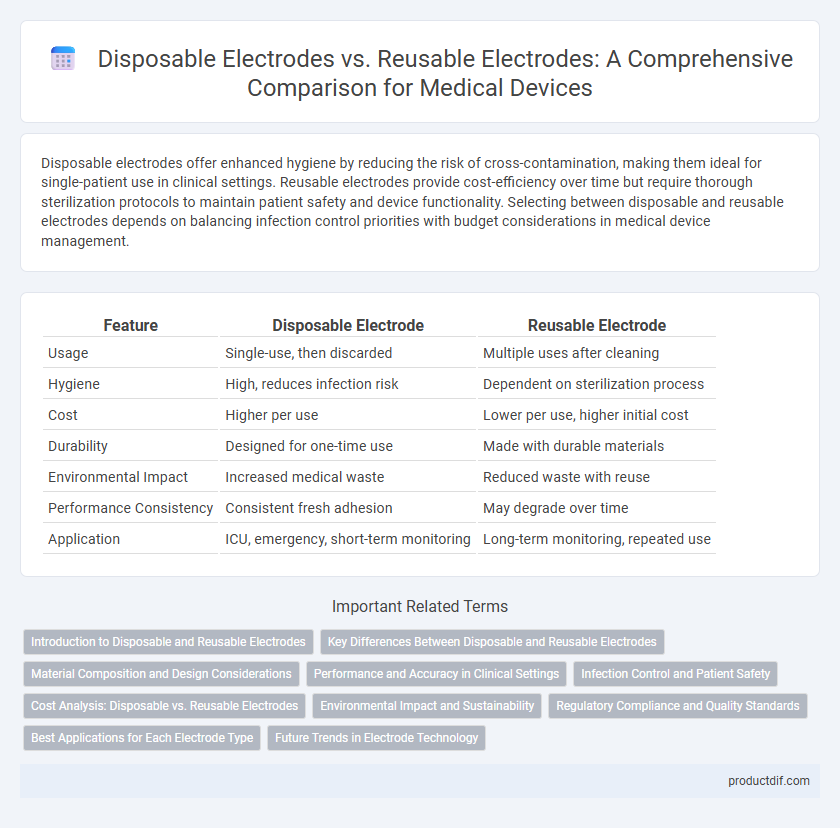Disposable electrodes offer enhanced hygiene by reducing the risk of cross-contamination, making them ideal for single-patient use in clinical settings. Reusable electrodes provide cost-efficiency over time but require thorough sterilization protocols to maintain patient safety and device functionality. Selecting between disposable and reusable electrodes depends on balancing infection control priorities with budget considerations in medical device management.
Table of Comparison
| Feature | Disposable Electrode | Reusable Electrode |
|---|---|---|
| Usage | Single-use, then discarded | Multiple uses after cleaning |
| Hygiene | High, reduces infection risk | Dependent on sterilization process |
| Cost | Higher per use | Lower per use, higher initial cost |
| Durability | Designed for one-time use | Made with durable materials |
| Environmental Impact | Increased medical waste | Reduced waste with reuse |
| Performance Consistency | Consistent fresh adhesion | May degrade over time |
| Application | ICU, emergency, short-term monitoring | Long-term monitoring, repeated use |
Introduction to Disposable and Reusable Electrodes
Disposable electrodes provide single-use convenience, reducing the risk of cross-contamination in medical diagnostics such as ECG and EEG monitoring. Reusable electrodes offer cost-effectiveness and durability, designed for multiple applications with proper cleaning and sterilization protocols. Selecting between disposable and reusable electrodes depends on clinical requirements, infection control standards, and budget considerations.
Key Differences Between Disposable and Reusable Electrodes
Disposable electrodes eliminate the risk of cross-contamination by offering single-use convenience, ensuring consistent signal quality without the need for sterilization. Reusable electrodes, while cost-effective over time, require rigorous cleaning and maintenance protocols to prevent infection and preserve electrode performance. Differences in material composition, longevity, and clinical application suitability further distinguish disposable from reusable electrodes in medical settings.
Material Composition and Design Considerations
Disposable electrodes are typically made from hypoallergenic materials such as hydrogel and non-woven fabrics to ensure patient comfort and reduce skin irritation, while reusable electrodes often incorporate durable silicone or carbon-based conductive composites to withstand repeated sterilization processes. The design of disposable electrodes emphasizes ease of use, adhesive reliability, and single-patient application to minimize infection risk, whereas reusable electrodes prioritize structural integrity, compatibility with various cleaning methods, and long-term conductivity stability. Material composition and design considerations directly influence performance, biocompatibility, and cost-effectiveness in clinical settings.
Performance and Accuracy in Clinical Settings
Disposable electrodes in clinical settings provide consistent performance and reduce variability caused by electrode degradation, ensuring higher accuracy in electrophysiological measurements. Reusable electrodes risk performance decline due to wear and contamination, potentially compromising signal quality and diagnostic precision. Selecting disposable electrodes enhances reliability in sensitive medical monitoring by maintaining stable impedance and minimizing noise artifacts.
Infection Control and Patient Safety
Disposable electrodes significantly reduce the risk of cross-contamination and hospital-acquired infections by eliminating the need for sterilization between uses, thereby enhancing patient safety in clinical settings. Reusable electrodes require rigorous cleaning and disinfection protocols to prevent microbial transmission, which can be challenging to maintain consistently and may compromise infection control. Selecting disposable electrodes aligns with infection prevention standards and minimizes potential outbreaks associated with contaminated medical devices.
Cost Analysis: Disposable vs. Reusable Electrodes
Disposable electrodes offer lower upfront costs and eliminate sterilization expenses but generate higher long-term expenditure due to single-use nature. Reusable electrodes require initial investment and ongoing maintenance, including cleaning and disinfecting, yet provide cost savings over multiple uses in high-volume clinical settings. Cost analysis must weigh patient safety, risk of cross-contamination, and total lifecycle expenses to determine optimal electrode choice for medical applications.
Environmental Impact and Sustainability
Disposable electrodes generate significant medical waste due to their single-use design, contributing to environmental pollution and increased landfill burden. Reusable electrodes offer a sustainable alternative by reducing waste output and resource consumption, though they require proper sterilization processes to prevent cross-contamination. Lifecycle assessments indicate that reusable electrodes minimize carbon footprint and ecological impact compared to disposable options in clinical settings.
Regulatory Compliance and Quality Standards
Disposable electrodes offer enhanced regulatory compliance by minimizing cross-contamination risks, aligning with FDA and ISO 13485 standards for single-use medical devices. Reusable electrodes require rigorous cleaning, sterilization protocols, and validation processes to meet stringent quality standards, increasing the complexity of compliance with agencies such as the FDA and EMA. Both electrode types must adhere to IEC 60601 electrical safety standards, but disposables typically streamline quality management by eliminating the need for reprocessing controls.
Best Applications for Each Electrode Type
Disposable electrodes are best suited for single-use applications in environments requiring strict infection control, such as surgery and emergency care, ensuring patient safety by preventing cross-contamination. Reusable electrodes excel in long-term monitoring scenarios like cardiac rehabilitation or routine diagnostics, offering cost-effectiveness and durability with proper sterilization protocols. Selecting the appropriate electrode type depends on clinical needs, frequency of use, and infection control requirements to optimize patient outcomes.
Future Trends in Electrode Technology
Emerging trends in electrode technology emphasize the development of advanced disposable electrodes with biocompatible materials and enhanced signal fidelity for improved patient safety and hygiene. Innovations in reusable electrodes focus on antimicrobial coatings and flexible sensor arrays to extend device lifespan while minimizing infection risks. Integration of wireless connectivity and AI-driven diagnostic capabilities is expected to revolutionize both electrode types, optimizing real-time monitoring and personalized medical interventions.
Disposable electrode vs Reusable electrode Infographic

 productdif.com
productdif.com